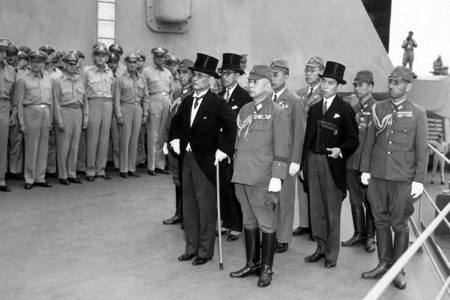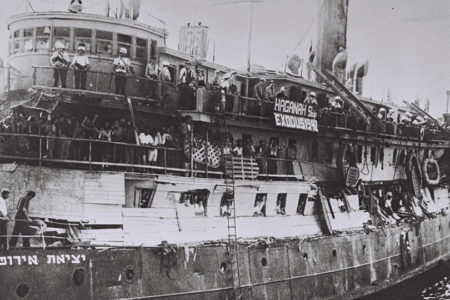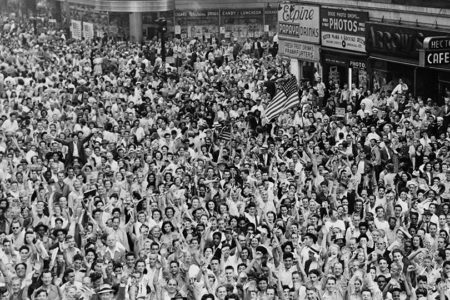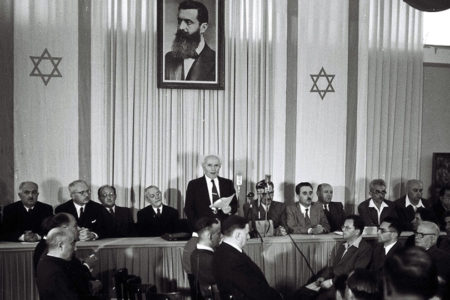The Miracle of Israel
Editor’s Note: The State of Israel is a modern nation with magnificent resort hotels gracing its breathtaking seashore, luscious fruits and vegetables, and groves of trees of every description. A trip to Israel today seems almost like a visit to Paradise.
In 1950 Israel was barely two years old, but already she had come through the 1948 War of Independence, and God was blessing her. She was a newcomer on the roster of nations, a country born in affliction and given scant chance of survival. Her people were distinctive, a unique mixture of emaciated Holocaust survivors who could speak only the languages of Europe and the rugged, Hebrew-speaking children of Jewish pioneers who had given their lives draining swamps and working the crusty, arid earth of the desert.
Israel My Glory was then in its eighth year. Dr. Victor Buksbazen traveled to the reborn nation of Israel and wrote this eyewitness account of the modern miracle that God had performed for His Chosen People. His report ran in the March 1950 issue of the magazine.
Glorious things of thee are spoken, Zion, city of our God.
Who of us has not thrilled to the sounds and words of the great hymn, “Glorious Things of Thee Are by John Newton and Franz Joseph Haydn! The word Zion often stands for Jerusalem and even for all the Holy Land. Literally, Zion means “arid place” or “dry land.” This indeed is the impression a visitor receives upon his first glimpse of Israel. As one looks on long stretches of arid land and stony hills, he wonders whether there can be any life out of this parched and seemingly dead soil. And yet the Lord has called it “the land flowing with milk and honey,” a “goodly land.” And so it is.
I was told by a Hebrew Christian that during the English occupation, a soldier came up to him and asked him with mock solemnity, “Sir, when does it begin to flow with milk and honey?” The brother answered him, “You just wait a little while and you will see.” Indeed, it is already beginning to flow. The valley of dry bones, the arid land, the stony hills, and the swampy marshes are coming back to life. The hour on God’s clock has struck.
The Jewish people who have come from distant parts of the world have found beneath the lifeless soil springs of water and deep wells, which they have tapped and used to irrigate the land. And behold, green, eye-pleasing, beautiful life has blossomed forth, rewarding the toil and love bestowed on it. Vegetable gardens of every kind and variety, citrus groves, luscious grain fields, and flower gardens have sprung up where there was no life for centuries.
The Contrast Between Israel and Ishmael
As you look upon the land, you are struck by the contrast. Here is a patch of land that has been tilled and cultivated according to modern methods with great care and much loving effort; and nearby, in striking contrast, is a patch of land producing either nothing or thistles and thorns. The hills of Judea and Galilee abound in stones. In fact, they are made up of stones, mostly of volcanic origin. What a gigantic task to turn these into arable land.
But then they came, those Jewish pioneers, refugees, and displaced persons, people without homes and without a land, destitute and hungry not only for bread but for a place under the sun that they might call home. They gathered out the stones, collected them into heaps, or made walls around their homesteads and little plots. They built the soil, literally from rock bottom. Lovingly, they turned it back to life and fertility, inch by inch. They terraced the hills, built up the topsoil, carried the water from afar, and a miracle happened. New community settlements called kibbutzim have sprung up, made up of Jews of every nationality and cultural background, but all united in one thought and desire: to have a homeland, a place of their own where they could live together without fear and in freedom.
It does not take long before the strange enchantment of the land takes hold of you, for this is the land upon which the Lord’s eye is turned in constant watchfulness, the world’s center on God’s own map. It is the land of God’s Chosen People, where the original pilgrims of God came to dwell in faith and on the strength of His promises. It is the land Moses saw from afar as he gazed longingly from the heights of Mt. Nebo, never to enter it, never to tread its sacred soil.
Land of Israel, home of the prophets, home of great kings, land of God’s wondrous revelation and destiny-shaping deeds. Israel, our Savior’s own land, where His earthly pilgrimage and work of salvation were performed. Hills of Galilee and shores of the Lake of Tiberias; cities and villages of Judah; Jerusalem the holy, where Israel’s crowning glory and the Son of God lived and preached, was crucified, arose from the dead, and is coming again as Israel’s King and Lord of all nations. These are some of the thoughts that press on your mind, make your heart beat with strange fascination, and well up your eyes with tears of longing. Land of Israel! Holy Land!
A strange country is Israel. Life is new and modern as tomorrow’s day and as ancient as the hills of Judea and Galilee, mingling in a strange symphony. There is the hustle and bustle of Tel Aviv, a teeming modern city of 300,000 built on the seashore with ships of many nations along her shores; with buses, taxis, cars, and trucks running through her streets; with banks, factories, and railroads, the epitome of modern life.
And behold, right in the midst of this noisy modernity comes a forlorn camel or a little donkey carrying an Arab woman with her few belongings. Like once the sun in the Valley of Aijalon, time has stood still for these more than two millennia. Such is Israel.
As you leave the big cities and go into the country, you see here and there an Arab plowing the field with a wooden plow, just as in the days of Ishmael, his forefather. A camel pulls a crude plow, scraping the earth just slightly. Nearby, a young Israeli in khaki and open-neck shirt drives an American tractor, leaving deep and even furrows behind him. He will do in a day as much as his neighbor in a whole month and do it more effectively.
In nearby fields you see young, sturdy-looking Jewish boys and girls busy in the vegetable patches, weeding, digging, and reaping. And wherever you turn, you see spurting streams of water irrigating the land. The artificial mist shines in the hot sun of Israel, producing a multitude of rainbows. This is a common sight in Israel today.
During the summer, the scorching desert winds called hamsin come from deep inland, making breathing difficult for man and plant alike. To protect the orange groves and other plantations from the ferocious heat of the wind, cypress trees have been planted all over Israel. They give shade to man and protect the trees from the fiery winds. Nothing is more striking in Israel than the everpresent, tall, graceful cypress—solemn guardian of Israel’s land.
The Impossible Happens
For many years the Zionists were faced with an insolvable problem—the fact of an Arab majority in Palestine. This was the Arabs’ strongest argument against Zionism. And then, all of a sudden, they decided to forsake their homes and run to neighboring Arab countries. There was no compelling need to do this; yet they succumbed to British as well as their own propaganda. The Arab chieftains told them, “Just leave your homes for a while, and then we will drive the Jews into the sea; and when you come back, you will have the pick of Jewish homes.”
But this was not to be. The Jewish authorities in many cases begged the Arabs to stay on and help in building up the land. Hebrew Christians in Haifa told me how the Jewish military drove around in trucks in the Arab section of the city, pleading with the Arabs by means of loudspeakers, begging them not to run away: “Remain in your homes. Remain in your homes. Do not be afraid. No harm will come to you. We shall live together peacefully. Carry on your daily work.”
Such was the message of the Jewish government. But nothing would induce most of these Arabs to stay. Now there are only about 100,000 Arabs in the whole of Israel among a Jewish population of nearly a million. They deserted their homes and their fields, and there isn’t much to which they can return. Many of their homes in the country were primitive. Some were destroyed in the fighting; and others have to be razed, being a menace to safety and health. Arab land, unless worked by Jewish laborers, looks dead and deserted. Many an orange grove is dried up for lack of irrigation and care.
What was it that made them leave, unless the hand of God was behind it to solve a seemingly impossible situation? Now hundreds of thousands of Jewish settlers have streamed in from all over Europe and elsewhere, occupying the places once settled by Arabs. Some arrangements will have to be made by the Israeli government and the Arab neighbors. But one thing seems to be sure: Not many Arabs will return.
The Valley of Destiny
Traveling through the beautiful hills of Galilee and not far from Nazareth, we saw at our feet the Valley of Jezreel beneath the Hill of Megiddo where the Battle of Armageddon is to take place, according to prophecy, and where the Lord will deal with the nations as they gather together against His people Israel. Some 150 years ago, Napoleon, when he came to this same spot, considered it the most perfect battleground for a great campaign. It is a panorama of great beauty and awe. But now it was lying peacefully, with the industrious hand of the Jewish farmers visible everywhere—green land with thriving settlements right in the heart of this valley of destiny. Oh, Israel, if thou hadst only known the day of thy visitation!
As we descend from the hills down the steep road, there are visible signs of recent battles everywhere. Burned-out trucks and buses ambushed by Arabs, the passengers killed without mercy.
We visited many of the Jewish settlements bearing scars of the recent war. Each one of them endured a prolonged siege of Arab armies, and each one has a tale of heroism to tell. Many of them have small cemeteries where Jewish men perished in the defense of their women and children. They held out for days, for weeks, and even for months. Their food was gone, their water tanks were shot through and dry, and their ammunition was exhausted. Wave after wave of Arabs kept coming. When their homes were burned, they dug themselves into the earth. They lived there for months in darkness with little air and scarcely any water and food. Yet they held out until rescued or until death came and delivered them. It is a story of devotion and love unto death, one of which the world knows little. Now the burned-out buildings stand as solemn witnesses of great events, but the survivors and newcomers are busy building up the ruins, nothing daunted.
Their first care is to provide homes and playgrounds for their children. Children seem to be their most precious possessions, their proud hope for the future. All day the parents work in the fields or barns, leaving their children in the care of kindergarten supervisors or teachers. In the evening, you see fathers pushing babies in their carriages and little ones nestling lovingly in their mother’s arms.
What joy it was to spend some time in Nazareth, our Savior’s home, and to walk through the narrow marketplace our Savior must have visited many a time. Arab merchants were displaying their wares or sitting in the narrow streets, oblivious to time and mankind, with swarms of flies settling on their wares and on the children. So many of the Arabs seem to suffer from trachoma, a terrible eye disease. It is only since Christian medical personnel have come to the Holy Land, mainly to work among the Jews, that medical help has been given to those afflicted. Now the Jewish people continue the task well begun, treating Jews and Arabs alike.
Telling the Story on the Galilee
The peaceful Sea of Galilee, with its fishing boats anchored near the shore, brings back so vividly our Savior and the simple fishermen whom He called to be fishers of men. It was my privilege to speak to a group of Jewish tourists from America, England, and Israel, telling them as we traveled along its shores, the story of Jesus, His ministry, His death upon the cross, His resurrection, and His coming again in glory. My fellow travelers listened with the greatest attention and asked searching questions, not in a spirit of antagonism, but really wanting to know. This was one of the most memorable experiences I was privileged to have in the Holy Land.
There modern Israel is coming face to face, whether she wants it or not, with her prophets; with her men of God; and, above all, with the Lord Jesus Christ, Israel’s Messiah. Truly the stones are speaking again and bearing testimony to Him.
Springs
in the Desert
Part of Israel that the Lord in His wisdom is restoring to life is the Negev, occupying about half of all Israeli territory. This ancient desert land is even more lifeless than other parts of Israel. In fact, it was not worked much even in Bible days. Now the desert is turning into a blossoming garden, at least in many parts, according to the Word of God.
Hundreds of miles of water pipes are being laid with the help of machinery imported from the United States, and foundations of new houses are being laid constantly. One sees a little piece of land tilled with tractors or horse and plow and a tent on the plot in which the men sleep. As soon as this work is completed, they will build a house and summon their families.
How is the miracle possible in the desert wilderness of the Negev? You will recall the psalmist praying to God, “Turn again our captivity, O LORD, like the streams in the Negev” (Ps. 126:4). Beneath the layers of sand, there is water. In spring after the heavy rains, the water breaks out from beneath the ground, only to disappear again during the hot summer. It comes back again in the spring, covering the whole wilderness with most beautiful flowers for a short period. Now the waters are being utilized to transform the wilderness into a Garden of Eden (Ezek. 36:35).
Thus the Word of God is again and again revealed in its truth and deeper meaning when the Bible is confronted with the Holy Land, where it was written and where every detail confirms its divine authorship.








What an amazing and well written article. What a privilege for the author to travel the land at such a pivotal time in Israel’s history! To God be the glory for the miracle of the state of Israel!